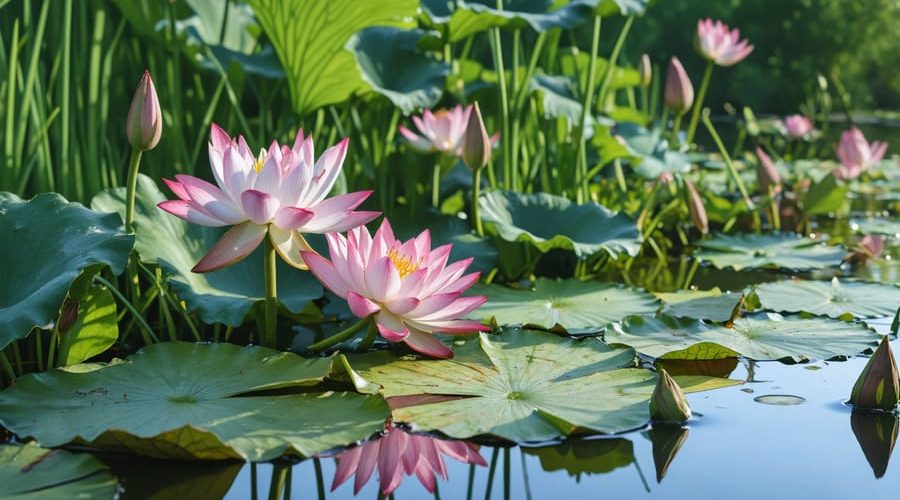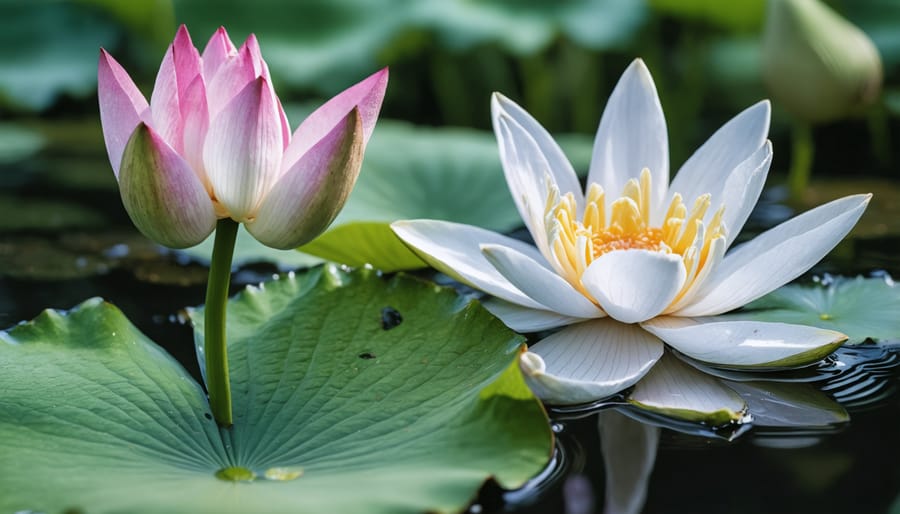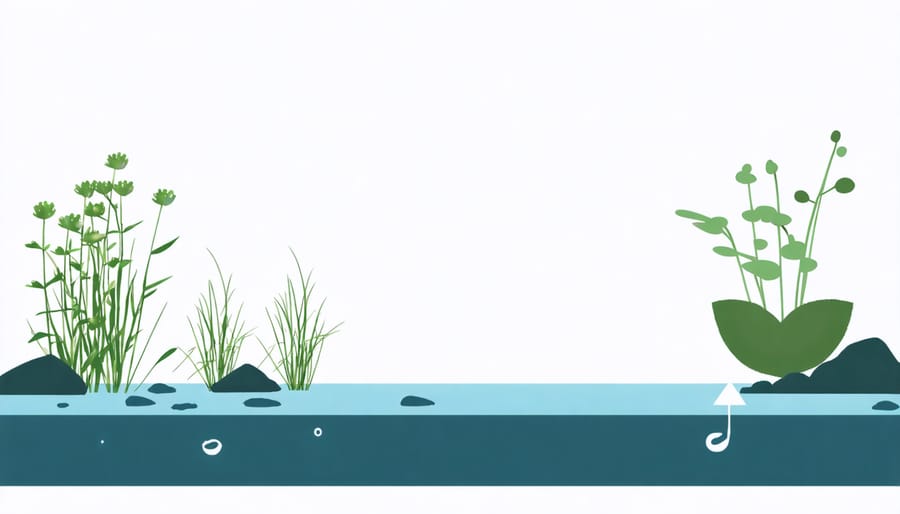
Beautiful Water Plants That Thrive in Cold Zone 5 Ponds
Transform your Zone 5 pond into a thriving water garden by selecting hardy aquatic plants that withstand winter temperatures dropping to -20°F (-28°C). Native water lilies, marsh marigolds, and cattails establish deep roots that survive beneath the ice, creating a self-sustaining ecosystem that returns vibrantly each spring. These cold-hardy varieties not only beautify your water feature but also help maintain water quality and provide essential shelter for pond wildlife.
Zone 5 pond plants fall into four essential categories: submerged oxygenators like hornwort, floating plants such as water lettuce (treated as annual), marginal plants including iris and rushes, and deep-water plants like hardy water lilies. Each plays a crucial role in balancing your pond’s ecosystem while offering stunning visual interest throughout the growing season. Whether you’re establishing a new water garden or enhancing an existing one, choosing the right combination of these zone-appropriate plants ensures year-round success, even through harsh winters.
Understanding your pond’s unique microclimates – from shallow margins to deep centers – allows you to create layers of interest while maximizing plant survival rates. This strategic approach to pond gardening in Zone 5 delivers both beauty and functionality, turning your water feature into a focal point that thrives season after season.
Hardy Water Lilies for Zone 5
Best Water Lily Varieties
Water gardens in zone 5 can showcase stunning hardy water lilies that thrive despite cold winters. The ‘Attraction’ variety is a top performer, featuring deep red blooms that appear from late spring through fall. Its compact growth makes it perfect for smaller ponds, while still offering impressive 6-inch flowers.
For those seeking pink blooms, ‘Pink Sensation’ is an excellent choice. This reliable variety produces abundant flowers and can withstand zone 5’s challenging climate. The ‘Colorado’ variety offers changing colors throughout the season, starting with peachy-pink and deepening to rich salmon, creating dynamic visual interest in your pond.
White water lily enthusiasts will love ‘Gladstone,’ known for its pure white petals and yellow centers. This classic variety is particularly vigorous and produces flowers consistently throughout the season. For something unique, try ‘Joey Tomocik,’ which displays buttery yellow blooms that stand out beautifully against dark water.
‘James Brydon’ is another standout performer, featuring rose-red flowers and being especially cold-hardy. This variety begins blooming earlier than most and continues well into fall. Remember that all these varieties need at least 6 hours of direct sunlight daily to produce their best blooms, and they should be planted in spring once water temperatures remain consistently above 60°F.

Planting and Winter Care
When planting your pond plants, start in spring after the last frost. Plant hardy varieties in containers filled with heavy garden soil, avoiding regular potting mix which can float away. Position containers so plants sit at their recommended depth – typically 4-12 inches below the water surface for marginal plants and 12-24 inches for deep-water plants.
For winter protection in zone 5, move tropical plants indoors before first frost. For hardy varieties, lower potted plants to the deepest part of your pond (at least 18 inches deep) where they won’t freeze solid. Cut back dead foliage to prevent decay. If your pond is shallow, consider moving hardy plants to a frost-free location like an unheated garage or basement, keeping their roots moist but not submerged.
Some plants, like hardy water lilies, can remain in deep water year-round. Cover your pond with netting in fall to prevent leaves from sinking and decomposing. Remember to remove snow build-up on any winter covers to maintain oxygen exchange. Come spring, gradually raise plants to their summer depths as temperatures warm.
Marginal Plants That Survive Zone 5 Winters
Native Marginal Options
Zone 5 ponds are naturally home to several beautiful native marginal plants that offer both aesthetic appeal and ecological benefits. The Blue Flag Iris is a stunning local favorite, producing vibrant purple-blue blooms in late spring while providing natural filtration for your pond. These hardy natives grow 2-3 feet tall and create excellent hiding spots for local wildlife.
Swamp Milkweed is another fantastic native choice, featuring clusters of pink flowers that attract butterflies and pollinators. This plant thrives in wet soil around pond edges and grows naturally throughout the region. Cardinal Flower adds brilliant red color to your pond’s edge while attracting hummingbirds with its tubular blooms.
For shorter options, consider Marsh Marigold, which produces cheerful yellow flowers in early spring and naturally dies back during summer. Sweet Flag offers attractive grass-like foliage and helps prevent erosion along pond edges. Joe Pye Weed is a taller option that provides late-summer interest with its pink flower clusters and can reach heights of 5-7 feet.
These native plants require minimal maintenance since they’re already adapted to local conditions. They’ll naturally spread over time, creating a established look around your pond while supporting local wildlife and maintaining water quality. Most will naturally go dormant in winter and emerge again in spring without any special care.

Ornamental Choices
Beautify your zone 5 pond with stunning ornamental plants that can withstand cold winters while adding visual interest throughout the growing season. Iris sibirica (Siberian Iris) stands as a top choice, producing elegant purple, blue, or white blooms in late spring and maintaining attractive sword-like foliage all season.
For dramatic height and structure, consider Typha minima (Dwarf Cattail), which grows to a manageable 2-3 feet and provides vertical interest without overwhelming smaller ponds. The feathery plumes of Acorus calamus (Sweet Flag) add texture and movement, while its variegated varieties offer striking gold-striped foliage.
Pontederia cordata (Pickerelweed) delivers a double punch with heart-shaped leaves and spikes of purple-blue flowers that attract butterflies. For ground-level beauty, Caltha palustris (Marsh Marigold) produces cheerful yellow blooms in early spring when the garden is just awakening.
Don’t overlook Sagittaria latifolia (Duck Potato) with its distinctive arrow-shaped leaves and delicate white flowers. For fall interest, Japanese Rush (Juncus effusus) maintains its structural presence well into the cold season and creates wonderful winter texture when frosted.
These hardy ornamentals require minimal maintenance – simply trim back dead foliage in late fall and ensure their roots stay submerged but not too deep. Most will naturally die back in winter and resurface vigorously in spring.
Submerged Oxygenating Plants
Cold-Hardy Varieties
For Zone 5 pond owners, several hardy oxygenating plants continue working their magic even when temperatures drop. The star performer is Elodea (Canadian Waterweed), which remains green and active throughout winter, ensuring your fish have a steady oxygen supply. This workhorse of cold-water ponds can survive under ice and starts growing again early in spring.
Hornwort is another champion winter survivor, maintaining its green foliage and oxygen production even in near-freezing conditions. Its fine, feathery leaves provide excellent surface area for beneficial bacteria and shelter for small aquatic life. While it may slow its growth in winter, it rarely goes completely dormant.
Water Starwort deserves special mention for its incredible cold tolerance. This native plant actually prefers cooler temperatures and continues to thrive when other plants have called it quits for the season. Its small, oval leaves remain active throughout winter, helping maintain water quality when it matters most.
For shallow areas, Marsh Marigold is a fantastic choice that starts producing oxygen early in spring, often while there’s still frost on the ground. Its bright yellow flowers are among the first to appear, bringing welcome color to your pond.
American Waterweed (Anacharis) rounds out the cold-hardy lineup with its robust nature and excellent oxygenating capabilities. It’s particularly valuable in Zone 5 ponds because it can withstand being frozen solid and will bounce back when temperatures rise.
These varieties not only help maintain healthy oxygen levels but also provide crucial winter shelter for fish and other pond life. While growth naturally slows during cold months, these plants continue working to keep your pond ecosystem balanced, making them essential additions to any Zone 5 water garden.
Floating Plants for Seasonal Beauty
Floating plants add a magical touch to zone 5 ponds during the warm season, creating a natural, layered look while helping to control algae growth. Water lettuce and water hyacinth are two popular choices that thrive from late spring through fall, providing excellent coverage and beautiful blooms.
Water hyacinth produces striking purple flowers and creates dense mats of foliage that offer shelter for fish and help reduce water temperature. While these plants multiply quickly, they’re easy to manage by simply removing excess growth. Water lettuce, with its velvety rosettes of pale green leaves, creates an attractive carpet effect on the water’s surface.
Since these floating beauties aren’t winter-hardy in zone 5, treat them as seasonal plants. When fall approaches, remove them from your pond before the first frost. You can overwinter a few plants indoors in a warm, well-lit aquarium or dispose of them and purchase new ones in spring.
For seasonal variety, consider adding duckweed or fairy moss to your collection. These tiny floating plants spread quickly and provide excellent nutrient absorption. During summer, they create a emerald-green blanket that smaller pond inhabitants love.
Remember to introduce floating plants gradually, starting with just a few specimens. This allows you to monitor their growth rate and maintain the right balance in your pond ecosystem. A good rule of thumb is to keep about 60% of your pond’s surface clear to ensure adequate oxygen exchange and allow other plants to receive sufficient sunlight.
Winter Protection Strategies
As winter approaches in Zone 5, protecting your pond plants becomes crucial for their survival through the harsh cold months. Successful winter preparation requires implementing proper winter protection techniques well before the first frost arrives.
For hardy water lilies and other submersible plants, trim back dead foliage and move them to the deepest part of your pond, ideally below the freeze line (about 18-24 inches deep). This natural insulation helps protect their roots from freezing. If your pond isn’t deep enough, consider temporarily relocating these plants to buckets in your basement or garage, keeping them in water at around 40-50°F.
Marginal plants require different handling based on their hardiness. For hardy varieties like cattails and iris, cut back the foliage to about 2-3 inches above the crown and sink the containers deeper in the pond. For less hardy marginals, remove them from the pond entirely and store them in a cool, dark place where temperatures remain above freezing.
Floating plants like water hyacinth and water lettuce typically won’t survive Zone 5 winters outdoors. Before the first frost, bring a few healthy specimens indoors. Place them in containers with pond water and position them near a sunny window. While they may not thrive during winter, they’ll survive to reproduce abundantly next spring.
For bog plants growing in the pond margin, apply a thick layer of mulch around their base using straw or leaves. This insulation helps protect their root systems. Consider adding a floating pond heater or de-icer to maintain a small opening in the ice, allowing for proper gas exchange and protecting your overwintering plants.
Remember to remove any tropical specimens completely from the pond before temperatures drop below 50°F. These can be overwintered as houseplants or stored in their dormant state, depending on the species. Keep them in a bright location where temperatures stay above 60°F.
Finally, avoid disturbing your plants during winter months once they’re properly positioned. Spring will reveal which protection methods worked best for your particular pond setup, allowing you to refine your strategy for the following year.

Creating a thriving pond garden in Zone 5 is an achievable and rewarding project. With the right mix of hardy marginals, floating plants, submerged vegetation, and beautiful water lilies, you can establish a vibrant aquatic ecosystem that returns year after year. Remember to focus on cold-hardy varieties, provide adequate winter protection, and maintain proper water depth for your chosen plants. Whether you’re a beginner or an experienced gardener, starting with just a few reliable species and gradually expanding your collection is a great approach. Your pond will not only enhance your landscape but also attract wildlife and create a peaceful oasis in your backyard. Don’t wait – spring is the perfect time to begin your Zone 5 water gardening adventure!
